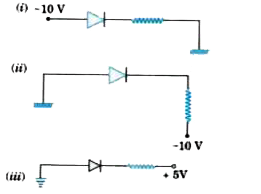The dominant mechanisms for motion of charge carriers in forward and reverse biased silicon P-N juntions are-
drift in forward bias diffusion in reverse
diffusion in forward bias and drift in reverse bias.
diffusion in both forward and reverse bias
drift in both forward and reverse bias
The correct Answer is:B
Step by step video, text & image solution for The dominant mechanisms for motion of charge carriers in forward and reverse biased silicon P-N juntions are- by Physics experts to help you in doubts & scoring excellent marks in Class 12 exams.
Updated on:21/07/2023Topper's Solved these Questions
Similar Questions
Knowledge Check
The dominant mechanisms for motion of charge carriers in forward and reverse biased silicon P−N junction are
ADrift in forwards bias, diffusion in reverse biaseBDiffusion in forward bias, drift in reverse biasCDiffusion in both forwards and reverse biaseDDrift in both forward and reverse biaseAssertion:The dominant mechanism for motion of charge carriers in forward and reverse biased silicon P−N junction are drift in both forward and reverse biase.
Reason: In reverse biasing, no current flow through the junction.AIf both the assertion and reason are true and reason is a true explantion of the assertion.BIf both the assertion and reason are true but the reason is not true the correct explantion of the assertion.CIf the assertion is true but reason falseDIf both the assertion and reason are false.Assertion : The dominant mechanism for motion of charge carreis in forward and reverse biased silicon P-N junction are drit in both forward and reverse bias.
Reaon : In reverse biasing, no current flow through the junction.AIf both assertion and reason are true and the reason is the correct explanation of the assertionBIf both assertion and reason are true but the reason is not the correct explanation of the assertionCIf assertio is true statement but reason is false.DIf both assertion and reason are false statement
Explain the working of a pn-junction diode in forward- and reverse-biased modes.
View Solutionwhich one of the two diodes is forward biased and which is reverse biased

View SolutionWhat accounts for the flow of charge carriers in forward and reverse biasing of sillicon P-N diode-
View SolutionThe reverse biasing in a p-n junction diode
View SolutionThe approximate ratio of resistance in the forward and reverse biase of the PN− junction diode is
View Solution